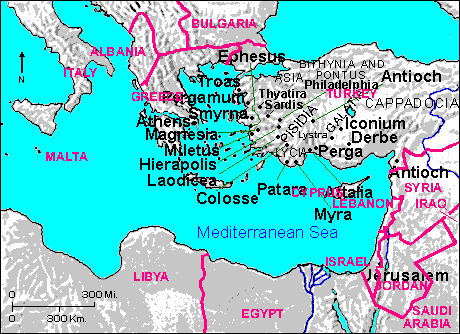1 & 2 TIMOTHY: LOCATION IN TIMOTHY
(Message by Tanny Keng)
 0. Timothy
0. Timothy
a) Honoring God, a young disciple who was Paul’s companion in many of his journeying. His mother, Eunice, and his grandmother, Lois, are mentioned as eminent for their piety (2 Timothy 1:5).
b) We know nothing of his father but that he was a Greek (Acts 16:1). He is first brought into notice at the time of Paul’s second visit to Lystra (Acts 16:2) where he probably resided, and where it seems he was converted during Paul’s first visit to that place (1 Timothy 1:2; 2 Timothy 3:11). The apostle having formed a high opinion of his "own son in the faith," arranged that he should become his companion (Acts 16:3) and took and circumcised him, so that he might conciliate the Jews.
c) He was designated to the office of an evangelist (1 Timothy 4:14) and went with Paul in his journey through Phrygia, Galatia, and Mysia; also to Troas and Philippi and Berea (Acts 17:14). Thence he followed Paul to Athens, and was sent by him with Silas on a mission to Thessalonica (Acts 17:15; 1 Thessalonians 3:2).
d) We next find him at Corinth (2 Corinthians 1:1) with Paul. He passes now out of sight for a few years, and is again noticed as with the apostle at Ephesus (Acts 19:22) whence he is sent on a mission into Macedonia.
e) He accompanied Paul afterwards into Asia (Acts 20:4) where he was with him for some time. When the apostle was a prisoner at Rome, Timothy joined him (Philippians 1:1) where it appears he also suffered imprisonment (Hebrews 13:23). During the apostle’s second imprisonment he wrote to Timothy, asking him to rejoin him as soon as possible, and to bring with him certain things which he had left at Troas, his cloak and parchments (2 Timothy 4:13 ). According to tradition, after the apostle’s death he settled in Ephesus as his sphere of labor, and there found a martyr’s grave.
The End ...
 0. Timothy
0. Timothya) Honoring God, a young disciple who was Paul’s companion in many of his journeying. His mother, Eunice, and his grandmother, Lois, are mentioned as eminent for their piety (2 Timothy 1:5).
b) We know nothing of his father but that he was a Greek (Acts 16:1). He is first brought into notice at the time of Paul’s second visit to Lystra (Acts 16:2) where he probably resided, and where it seems he was converted during Paul’s first visit to that place (1 Timothy 1:2; 2 Timothy 3:11). The apostle having formed a high opinion of his "own son in the faith," arranged that he should become his companion (Acts 16:3) and took and circumcised him, so that he might conciliate the Jews.
c) He was designated to the office of an evangelist (1 Timothy 4:14) and went with Paul in his journey through Phrygia, Galatia, and Mysia; also to Troas and Philippi and Berea (Acts 17:14). Thence he followed Paul to Athens, and was sent by him with Silas on a mission to Thessalonica (Acts 17:15; 1 Thessalonians 3:2).
d) We next find him at Corinth (2 Corinthians 1:1) with Paul. He passes now out of sight for a few years, and is again noticed as with the apostle at Ephesus (Acts 19:22) whence he is sent on a mission into Macedonia.
e) He accompanied Paul afterwards into Asia (Acts 20:4) where he was with him for some time. When the apostle was a prisoner at Rome, Timothy joined him (Philippians 1:1) where it appears he also suffered imprisonment (Hebrews 13:23). During the apostle’s second imprisonment he wrote to Timothy, asking him to rejoin him as soon as possible, and to bring with him certain things which he had left at Troas, his cloak and parchments (2 Timothy 4:13 ). According to tradition, after the apostle’s death he settled in Ephesus as his sphere of labor, and there found a martyr’s grave.
The End ...
Comments
Post a Comment